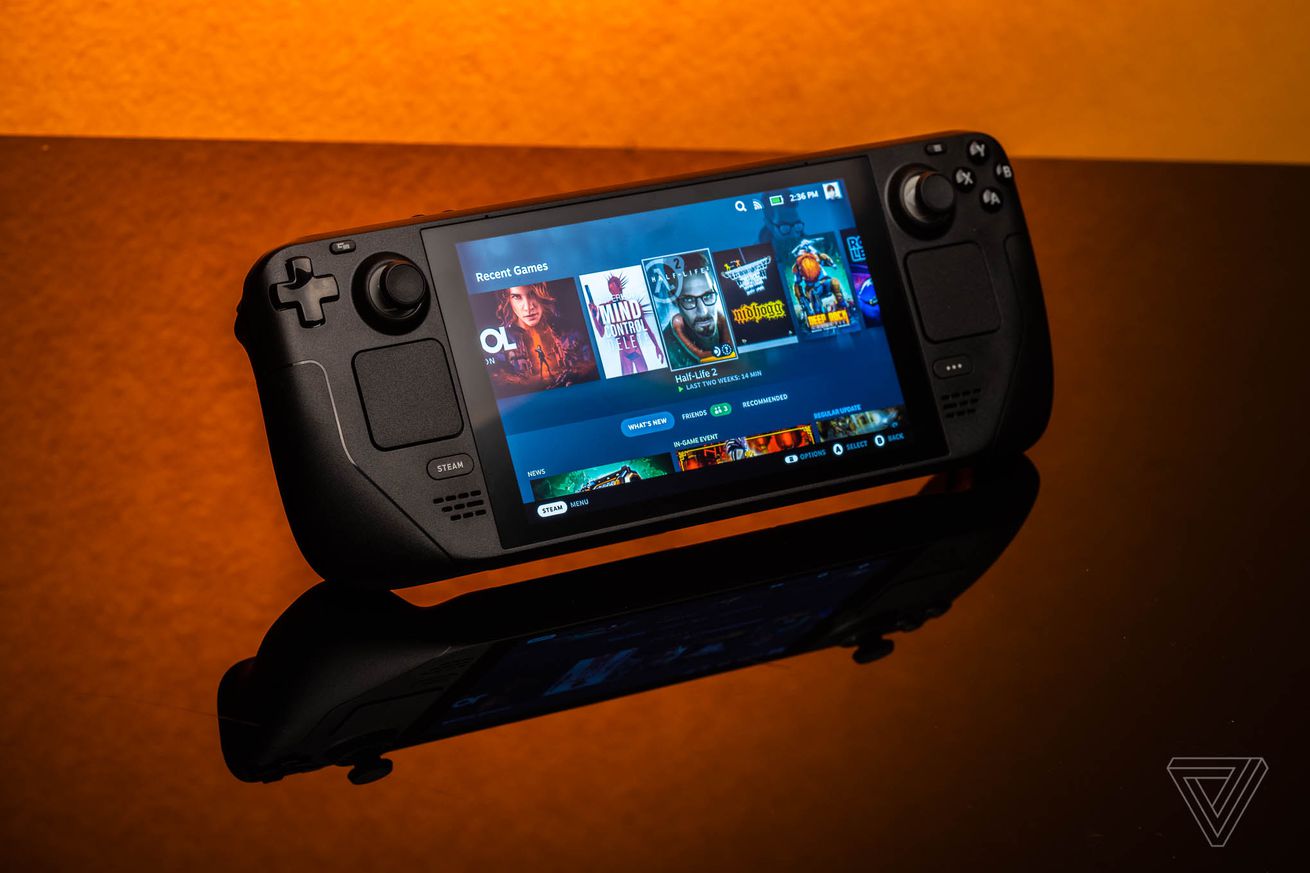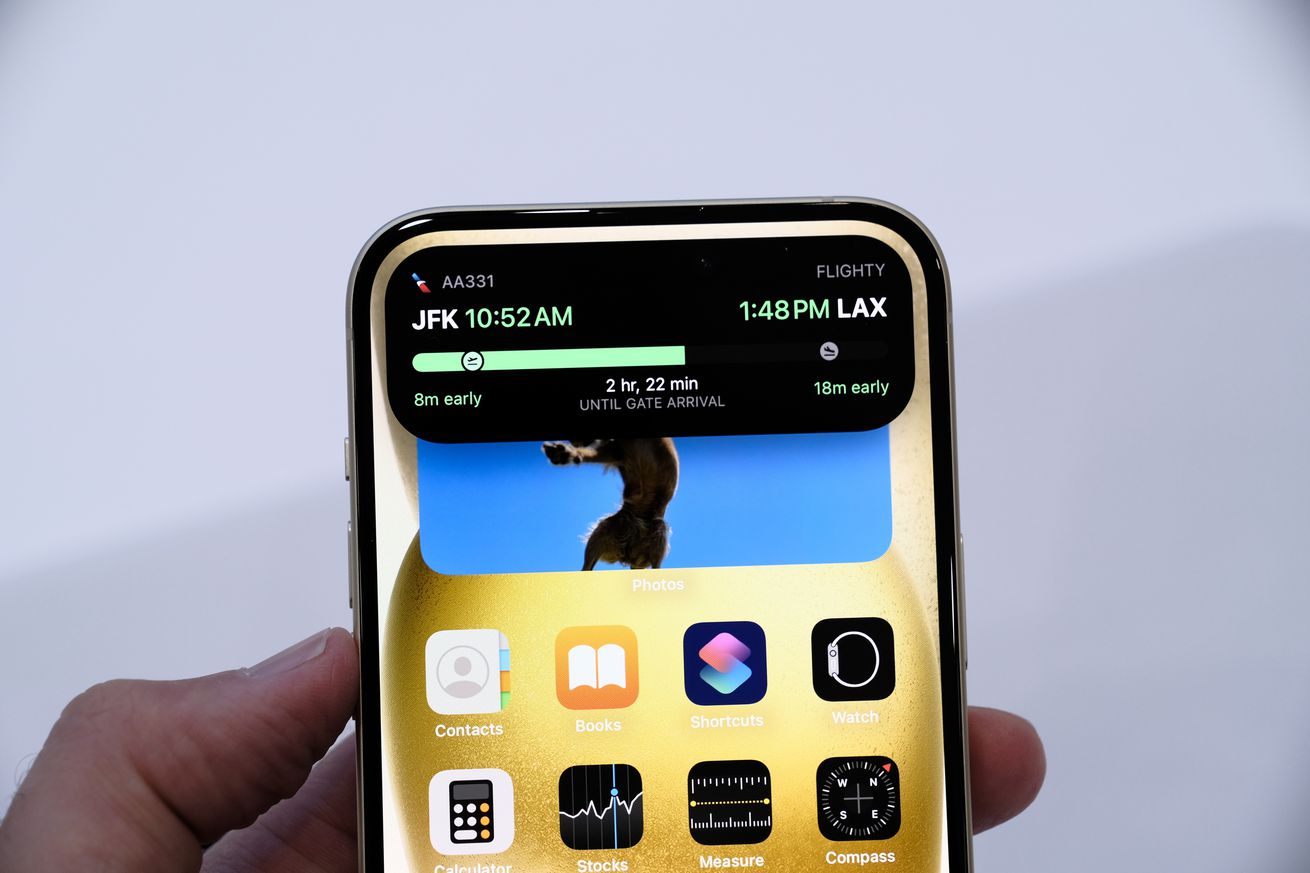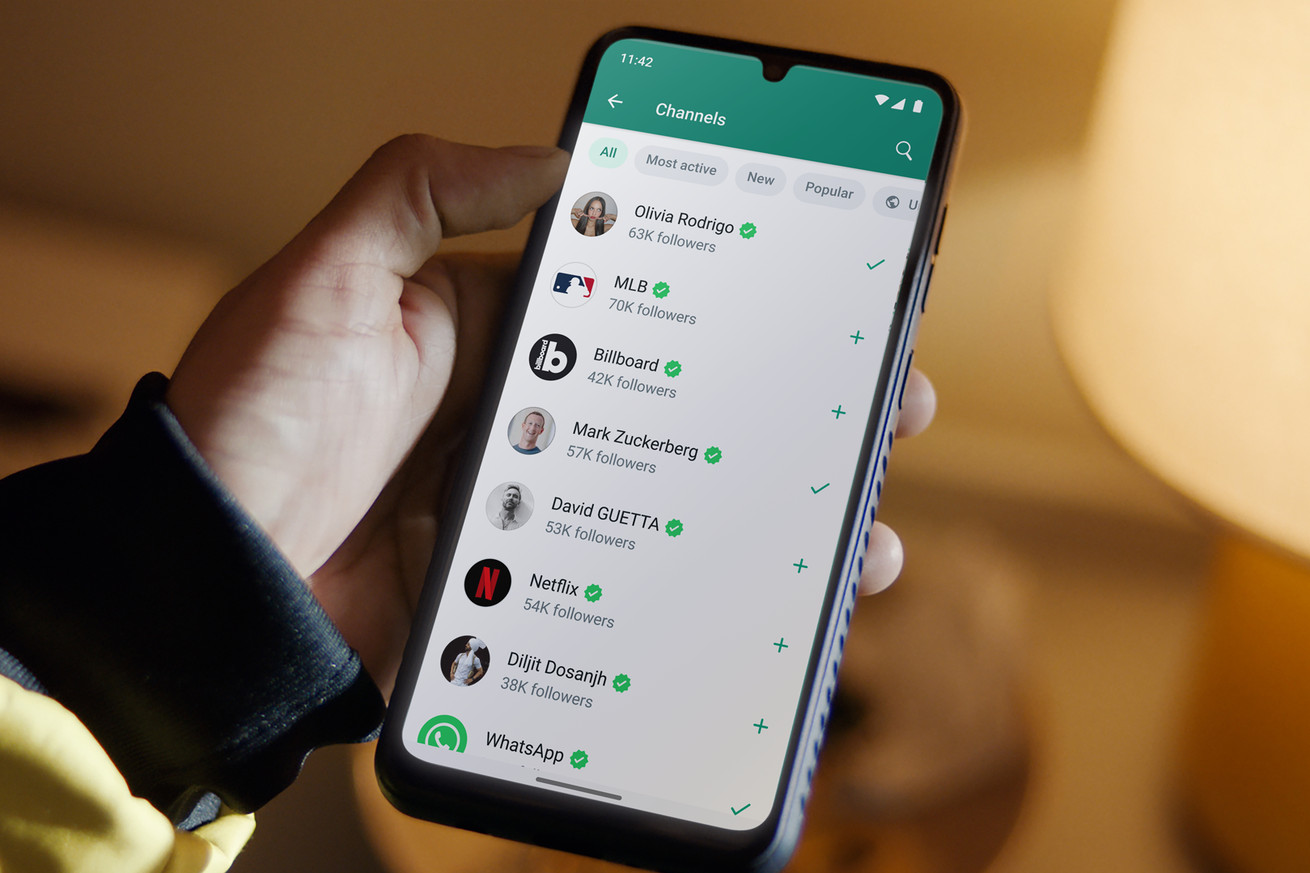
Hi, friends! Welcome to Installer No. 6, your guide to the best and Verge-iest stuff in the world. (If you’re new here, first of all, hi, hello, welcome, and second of all, you can read all the old editions at the Installer homepage.)
This week, I’ve been watching the wacky sci-fi series Command Z from Steven Soderbergh, updating all my browsers to fix a scary security issue, reading and listening to Cory Doctorow rage against Big Tech, cackling at this video about the state of the Hyperloop, trying the Endel app as work music instead of my all-day movie soundtracks playlist, and slowly cleaning up my camera roll with some help from Swipewipe.
Also this week, I have for you a bunch of new Apple gear (shocking, I know), two books worth reading, an app for keeping your family on schedule, some fun AI, and Graham MacAree’s seriously minimalist homescreen.
(As always, the best part of Installer is your ideas and tips. What do you want to know more about? What awesome tricks do you know that everyone else should? What app should everyone be using? Tell me everything: installer@theverge.com. And if you want to get every issue of Installer a day early in your email inbox you can subscribe here.)
The Drop
- The iPhones 15. It’s been a few days since the Apple event, and I’m still not sure whether I’m excited about the iPhone 15 and 15 Pro. I like the titanium on the Pro, the camera, and that it’s lighter! And yay, USB-C! But that’s… kinda it. I think my 14 will do me just fine for another year, but if you do upgrade, know that I’ll be at least slightly jealous.
- Apple’s USB-C EarPods. Now these, I am unequivocally into. I’ve spent years telling everyone to just buy a pair of EarPods and keep them in your bag — they’re $19, their sound quality is meh, but their mic quality is fantastic, and they’re super useful for phone calls / voice dictation / whenever your wireless headphones’ battery dies. The new ones will work with your phone, laptop, work computer, and basically everything else. I already bought two pairs.
- A Million Miles Away. Amazon’s latest original movie is based on the story of José Hernández, a migrant farmworker who became a NASA flight engineer and went to the International Space Station. (He was also apparently the first person to tweet in Spanish from space, which is a very cool and very specific thing to track.) A feel-good movie for the weekend if that’s what you’re looking for.
- The Six: The Untold Story of America’s First Women Astronauts. Speaking of great space stories, Bloomberg reporter (and Verge alum!) Loren Grush wrote a great book about the six women who helped expand and change the American space program and the huge amount of sexism and pushback they received in the process. Grush was also on our Decoder podcast this week, too — it’s a good listen.
- Elon Musk. Big week for tech books, apparently! I confess I have not yet cracked Walter Isaacson’s 688-page tome, but I’ve been devouring excerpts and reviews, many of which say the same thing: Elon Musk is a deeply complicated person, definitely a smart person, maybe not a very good person, and it’s definitely worth asking hard questions about our present and future.
- Spotify’s Daylist. The most interesting question in the music business right now is this: how do you differentiate yourself when everybody has all the same content? The thing Spotify does best is ultra-personalized playlists, and Daylist is an ever-changing, AI-curated one that supposedly matches your mood all day and night. So far, mine have been deeply weird — I woke up the other day to “mountain music indie folk thursday morning,” which, sure — but I really dig the idea.
- Stable Audio. I’m currently deep down the rabbit hole of AI music-making tools (for a Vergecast episode coming Monday!), and Stable Audio is one of the more impressive tools I’ve seen. It comes from Stability AI, which also makes the image-generating Stable Diffusion, and works basically the same way: describe the music you want to hear, and a few seconds later, it appears. Nothing I’ve made so far is going to top charts anytime soon, but it’s an incredibly fun thing to play with.
- Monster Hunter Now. This is definitely not a full-on Monster Hunter game for your phone. And The Verge’s Andrew Webster found it a little lacking in depth and strategy. But what it is — a real-world game like Pokemon Go in which you fight monsters and collect gear while you wait in line at the grocery store — is still pretty compelling.
- Artifact Links. A very important genre of app to me is the Puttering App, the one I can just open and scroll through for a few minutes at a time in the hopes of finding something fun / interesting / useful. Twitter was kinda that, Instagram and Reddit are still kinda that, and Artifact wants to be exactly that. The news-reading app now lets you post any URL on the web, and already, I’m finding tons of good stuff following a few smart people.
Pro tips
It’s the time of year when suddenly I find myself hating my phone. There are new phones coming out, new versions of Android and iOS to be had, cool new features and apps and just so much new stuff to play with! But this year, rather than buy a new phone to satiate that urge, I’m going to try giving my phone a makeover.
For advice, I turned to Isaac Mosna, who you might know better as Canoopsy on YouTube and around the web. He makes great tech videos but also creates wallpapers, icons, and more cool phone stuff. I asked him to share a few tips on how to better customize your phone so that mine might look as cool as his does:
- Start fresh. “Take everything off your homescreen, put it in the app library, and then start dragging things over. It’s a great way to start fresh without really starting fresh if you’ve had the same phone for a while.”
- Have just one way to do things. “Try going with a very minimal setup. Don’t have your camera in the dock since you can use the Control Center. Android and iOS both can make your phone simpler, easier to use, and more enjoyable. No one likes to see 1,000 things when they turn their phone on.”
- Keep it changing. “Find ways to cycle through different wallpapers, like by setting an album instead of a single picture. Whether it’s something that changes every hour or every time you turn your phone on, it’s a great way to have a new phone every time.”
- Embrace space. “On Android, it’s really easy to leave empty spots on the screen. On iOS, you can use things like Clear Spaces to have blank spaces or put everything on one side of your phone where your hand naturally rests.”
- Hide your widgets. “With Clear Spaces, you can also make widget stacks where you have the blank widget on your homescreen and then swipe to something else — it’s like a hidden drawer of widgets. It’s pretty fun.”
- One homescreen. One. “I can’t think with multiple homescreens. Either put everything else in the app library or drawer or categorize things into folders on your homescreen.”
Screen share
Last week, when I asked Jennifer Pattison Tuohy to share her homescreen, it sparked a whole discussion in the Verge newsroom about how many apps we all had. Most people, not surprisingly, had a lot!
Graham MacAree, a senior storytelling engineer here at The Verge, did not have a lot. He had 22. And even that, he decided, was too many. So I figured, in a time of new phones and new software and general technological maximalism, I’d see what life was like alllllll the way on the other side.
Here’s Graham’s homescreen, plus some info on the apps he uses and why:
/cdn.vox-cdn.com/uploads/chorus_asset/file/24924800/IMG_63B62D28F622_1.jpeg) Image: Graham MacAree / The Verge
Image: Graham MacAree / The Verge
The Phone: An iPhone 13 Pro. This is the first phone I’ve owned that I actually enjoy using ... ish.
The Apps: Everyone’s on WhatsApp in England, so I only really need one chat app. Gmail, Messages, and Authenticator are all fairly standard. I’ve found Citymapper to be better than Maps at helping me navigate London’s various transit outages, and I reluctantly use Uber when said outages inconvenience me too much.
Monzo is a British bank, and it’s on my phone because it’s app-only. My Roomba helps keep my house “free” of dog hair, and then Pokémon Home lets me continue my extremely low-key quest for a living Pokédex. MLB is for when the Seattle Mariners are playing while I’m out and about (live sports are basically the only things I’ll watch on a phone screen). Spotify gets used a lot, as does Chrome. Having quit Twitter and Facebook, I don’t have any social media apps at the moment, but I’m sometimes briefly tempted by Bluesky.
In general, I’m exactly the right age to have learned to do everything on my computer instead of my phone, and I’ve never updated my habits in light of the fact that I live in the 21st century. If I use something more than once a month or so, it lives on the homescreen.
The Wallpaper: Normally, this would be a photograph of my children, but I’d rather they not be online. I temporarily switched my wallpaper to a cool picture of Sharpless 132, which is about 10,000 light-years away. It’s basically an enormous gas cloud, which hides some incredibly massive/bright stars. Also, my dad took the photograph, so that’s neat, too.
As always, I also asked Graham to share a few things he’s into right now. Here’s what he shared:
- Dancing! I have begun choreography for an Argentine Tango recital in November, so that’ll occupy quite a lot of my life over the near future. I’ve been dancing seriously for almost three years now and do performances about twice a year. It’s nerve-wracking but fun.
- Painting videos. I’m playing around with the idea of getting back into Warhammer 40,000 because painting tiny people / monsters / tanks seems potentially relaxing. Right now, that idea manifests itself as watching other people paint tiny people / monsters / tanks, which is definitely relaxing. Will I ever progress to doing this myself? Who can say.
Crowdsourced
Here’s what the Installer community is into this week. I want to know what you’re into right now as well! Email installer@theverge.com with your recommendations for anything and everything, and we’ll feature some of our favorites here every week.
“A lot of my life, online and offline, is captured on Futureland — a journal / routine organizer / tracker hybrid that can be a little hard to explain but feels wonderfully organic in practice. One of the few quiet, satisfying places on the internet, and the only app on my phone that consistently gets me looking up from the screen and moving toward what I want to be doing.” — Min-Taec
“Currently addicted to playing Finity on Apple Arcade.” — Scott
“Calculator apps are boring and haven’t seen any innovation, until Numbr! It’s a notepad mixed with a calculator, and I’ve used it exclusively as my calculator for several years. It’s primarily a web app, but there’s also a handy Chrome extension, and all the syntax is explained on their Github.” — Ross
“I have been OBSESSED with Usagi Shima, a little bunny-collecting chill island game with vibes reminiscent of Neko Atsume and a bit of Animal Crossing relaxation.” — Evelyn
“Subscribed to Tessie. Allows my Apple Watch to be used as a Tesla key similar to my phone. Not sure how to feel about it, but it’s been super convenient!” — Chris
“My wife found the app FamilyWall — it is our common app for recipes, meal planning, contacts, budgets, and bucket lists. What I like is that the app connects things: when I enter a recipe, I can plan the meal for a specific day and add the ingredients to the grocery list. I can also connect the calendar with other Outlook calendars so I have private and work calendars in sight. Additionally, we can share notes and pictures and make individual timetables.” — Chris
“One Sec. This app primarily allows you to set up a delay (referred to as an intervention) when opening specified apps. As an example, I have a 20-second breathing exercise intervention setup when opening up social media apps on my phone, and it won’t let me access the app until that exercise is complete. I have found it very useful in getting my attention when I mindlessly open up social apps during the day or during small waiting periods like waiting for a coffee. It’s a subscription app for iOS and Android (Android is a beta), but it’s pretty cheap, and they have a one-time license if you don’t want the constant subscription.” – Andrew
“The new Camera app from Blackmagic, plus their cloud integration so that multiple cameras can all upload to Davinci at the same time.” — Iestyn
“Instead of relying on Rotten Tomatoes for questionable movie ratings, use Letterboxd. As a bonus, some of the reviews for the really bad movies are super fun. The Flash, with 2.7 stars out of 5: ‘the cgi in this movie makes superman’s mustache removal look like a work of art.’ Honesty and humor. Chefs kiss. ” — Brandon
“Flight Radar 24 is wonderful. Want to know where that jet overhead is headed? Pop open the app and turn on AR for a live overlay. I also have all emergency alerts as silent notifications. Occasionally, you get military jets or big flight diversions. This week, I found out the SIN-JFK longest flight in the world goes over my parent’s house.” — Sean
“I’m actively listening and changing my ringtone and notification sounds with the ones introduced by iOS 17. They’re so good!” — Gabriel
Signing off
I am obsessed with scooters. Scooters you buy, scooters you rent, scooters you pay for by the minute and then throw into the river when you’re done — I love them all. And I can’t remember the last time I fell for a scooter like the new Honda Motocompacto. It is utterly impractical in every way — only 12 miles of range, weighs over 40 pounds, looks like a giant floppy disk on two wheels, costs $995 — but I want to toodle around my neighborhood on this thing in a way you would not believe. More weird scooter design, please!
See you next week!

/cdn.vox-cdn.com/uploads/chorus_asset/file/24925649/IMG_0697.jpeg) Photo by Umar Shakir / The Verge
Photo by Umar Shakir / The Verge
/cdn.vox-cdn.com/uploads/chorus_asset/file/24063992/USB_Performance_Logos.jpg) Image: USB-IF
Image: USB-IF
/cdn.vox-cdn.com/uploads/chorus_asset/file/24525448/236583_Nomad_Stand_One_MagSafe_ADiBenedetto_0008.jpg) Photo by Antonio G. Di Benedetto / The Verge
Photo by Antonio G. Di Benedetto / The Verge

/cdn.vox-cdn.com/uploads/chorus_asset/file/22024810/dbohn_201109_4283_0004.0.jpg) Photo by Dieter Bohn / The Verge
Photo by Dieter Bohn / The Verge




/cdn.vox-cdn.com/uploads/chorus_asset/file/24925710/speedsmart_iphone_pro.jpeg) Image:
Image: 


/cdn.vox-cdn.com/uploads/chorus_asset/file/24923790/d9e7f67d_e88c_42b7_b673_38baabec5013.png) Image: Microsoft
Image: Microsoft

/cdn.vox-cdn.com/uploads/chorus_asset/file/24101281/DSCF0042.jpg) Photo by Chris Welch / The Verge
Photo by Chris Welch / The Verge


/cdn.vox-cdn.com/uploads/chorus_asset/file/24920795/iFixit_Google_Pixel_Tablet.jpg) Image: iFixit
Image: iFixit

/cdn.vox-cdn.com/uploads/chorus_asset/file/24919998/GeForceNOW_hD6cMgYfO2.jpg) Screenshot by Sean Hollister / The Verge
Screenshot by Sean Hollister / The Verge
/cdn.vox-cdn.com/uploads/chorus_asset/file/24919985/GeForceNOW_riiPmcODVG.jpg) Screenshot by Sean Hollister / The Verge
Screenshot by Sean Hollister / The Verge
/cdn.vox-cdn.com/uploads/chorus_asset/file/24919970/IMG_7862_EDIT.jpg) Photo by Sean Hollister / The Verge
Photo by Sean Hollister / The Verge
/cdn.vox-cdn.com/uploads/chorus_asset/file/24919977/GeForceNOW_A4cQy1Fg6Z.jpg) Screenshot by Sean Hollister / The Verge
Screenshot by Sean Hollister / The Verge
/cdn.vox-cdn.com/uploads/chorus_asset/file/24919978/GeForceNOW_vX6bhHvWWz.jpg) Screenshot by Sean Hollister / The Verge
Screenshot by Sean Hollister / The Verge
/cdn.vox-cdn.com/uploads/chorus_asset/file/24919980/GeForceNOW_21geRmdNzs.jpg) Screenshot by Sean Hollister / The Verge
Screenshot by Sean Hollister / The Verge
/cdn.vox-cdn.com/uploads/chorus_asset/file/24919990/GeForceNOW_kZon4AVTvW.jpg) Screenshot by Sean Hollister / The Verge
Screenshot by Sean Hollister / The Verge
/cdn.vox-cdn.com/uploads/chorus_asset/file/24919991/GeForceNOW_z5GZIX6h9f.jpg) Screenshot by Sean Hollister / The Verge
Screenshot by Sean Hollister / The Verge


/cdn.vox-cdn.com/uploads/chorus_asset/file/24917803/Premiere_Pro_Text_Based_Editing_Filler_Word_Detection.png) Image: Adobe
Image: Adobe
/cdn.vox-cdn.com/uploads/chorus_asset/file/24917804/Frame.io_Adobe_Comment_Faster.png) Image: Adobe
Image: Adobe

/cdn.vox-cdn.com/uploads/chorus_asset/file/24820509/53073631148_27237a2761_h.jpg) Image: Sony
Image: Sony
/cdn.vox-cdn.com/uploads/chorus_asset/file/24820507/53072548002_6b6aafa5ff_h.jpg) Image: Sony
Image: Sony
/cdn.vox-cdn.com/uploads/chorus_asset/file/24917833/708371c5004de59569346f49b8e70a853348b7b5_scaled.jpg) Image: Sony
Image: Sony
